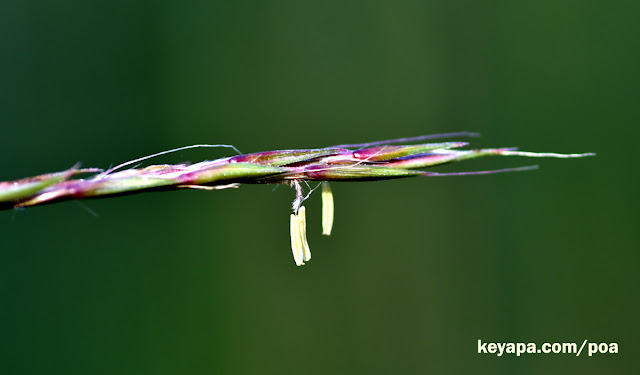 |
| Inflorescence of Andropogon gerardii |
Little did I know when we started our hike at the Environmental Education Center (EEC) at Lord Stirling Park that I would finally encounter and identify one of my more sought after species, one of the members of the legendary "Four Horsemen" of the Tall Grass Prairies. These 4 native grasses (Andropogon gerardii/Big Bluestem, Panicum virgatum/Swirchgrass, Sorghatrum nutans/Indiangrass, and Schizachyrium scoparium/Little Bluestem) dominated vast swathes of America before giving way to the spread of another type of grassland with the introduction of corn.
I was not expecting much because the EEC is located in the Great Swamp National Wildlife Refuge, a remnant of the Wisconsin Glacier, which retreated around 11,000 years ago to form the New Jersey Wetlands. So I thought I would see lots of marshy areas, wilt under the high humidity, and of course be attacked by lots of mosquitoes.
What I did not expect was a very well maintained, and honestly impressive trail system, but that's what I saw. A significant proportion of the path was on wooden boardwalks, which was impressive, and the trails were wide enough that you didn't have to touch vegetation on either side - always a recipe for picking up ticks. It even had a garden near the EEC building, with labeled plants, though not many of the plants were flowering at the time we went there.
 |
| Carpet of Microstegium vimineum |
We found a trail map of the area and decided that we would move from trail to trail along the periphery of the place, thus maximizing our hiking time. We first traveled counter clockwise along the yellow trail towards Lenape Meadow, and as usual I saw lots of Microstegium vimineum (Stiltgrass) covering the sides of the path, as well as sometimes extending deeper into canopy. This invasive grass is the bane of forest managers, and I had already grown used to encountering it every time I entered some forested area. You can identify stilt grass by the bamboo-like leaves as well as the silvery stripe that runs along the upper leaf surface.
 |
| Close up of leaves of Microstegium vimineum |
Fortunately however, we did encounter some other plants along the way, including a quite striking plant with dark red flowers, which I later identified as Lobelia cardinalis.
 |
| Lobelia cardinalis |
We also saw lots of cattails (Typha species) as we crossed the Boondocks Boardwalk along the north end of Lord Stirling Park. The sight of so many cattails was interesting and unexpected because this plant is being pushed aside by a grass called Phragmites australis in most places.. The reason for its health in the area seems to be because the park managers are actively controlling populations of the invasive grass.
 |
| Cattail |
But what excited me at first was the sight of clumps of S. scoparium (Little Bluestem) at Lenape Meadow.
 |
| A clump of S. scoparium at Lenape Meadow (center of pic) |
I've always been fond of this species ever since I saw fields of it in New Hampshire, with the distinctive red flowerheads arrowing stright up into the air. Of course, it's only early August, so the S. scoparium I saw at Lenape Meadow still had not gained their full beauty.
 |
| S. scoparium in New Hampshire |
However, my delight at the discovery of my old friend Little Bluestem was nothing to the amazement that I experienced when we passed Alexander Meadow at the extreme southwest of the park. There I saw a field of grass that almost made my jaw drop. Rising more than 3 meters into the air were flowerheads that looked like turkey feet waving in the air. I had come upon my first field of A. gerardii (Big Bluestem)!!!!
I believe I have never encountered this species before, ever since I started learning more about grasses last year. The distinctive turkey feet flowerheads and towering height made them almost instantly recognizable, and we passed through the meadow surrounded by these impressive grasses.
 |
| A. gerardii inflorescence, looking like turkey feet |
I took a few macroshots of the spikelets, which were tightly appressed and had a few dangling yellow or red anthers, although it was obvious that full anthesis had not yet started for many flowerheads.
I also saw quite a number of P. virgatum (Switchgrass) in the field, their wispy flowerheads forming almost a mist-like cloud above the grasses. This species is the 3rd member of the Four Horsemen of the Tall Grass Prairie present in the park, and I had a feeling the 4th and final member (Sorghastrum nutans) might also be somewhere there, although I did not have time to explore the place further.
 |
| P.virgatum flowerheads |
In the end, it was a very nice and productive hike, although we did sweat throughout the experience, and were bitten by quite a few mosquitoes.


No comments:
Post a Comment